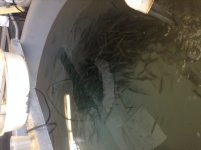Dave_W
Moderator
Staff member
The PFBC recently identified a viable population of naturally reproducing muskellunge in the North Branch of the Susquehanna River and so stocking will be dropped there. Evidence of such spawning success (and in other rivers across the state) has been mounting for awhile as well as having been rumored by anglers for years. Similar findings of wild fish and cessation of muskie stocking has already been implemented on the West Branch.
Anyway, the PFBC's study has verified the wild population. Even better - the results found revealed a wild population that is producing young fish at about twice the rate that Wisconsin considers to be a viable wild muskie population. In addition to the spawning success, the PFBC was surprised to discover that the growth rate of the wild fingerlings was twice that of the fingerlings in the hatchery system.
"Class A for Muskies" anyone?
While I still think we need to stock muskies in our state's rivers (although perhaps on a reduced or yearling basis) this discovery is great news and bodes well for toothie guys as well as providing a new angle to the PFBC's current review of muskie management.
Anyway, the PFBC's study has verified the wild population. Even better - the results found revealed a wild population that is producing young fish at about twice the rate that Wisconsin considers to be a viable wild muskie population. In addition to the spawning success, the PFBC was surprised to discover that the growth rate of the wild fingerlings was twice that of the fingerlings in the hatchery system.
"Class A for Muskies" anyone?
While I still think we need to stock muskies in our state's rivers (although perhaps on a reduced or yearling basis) this discovery is great news and bodes well for toothie guys as well as providing a new angle to the PFBC's current review of muskie management.




